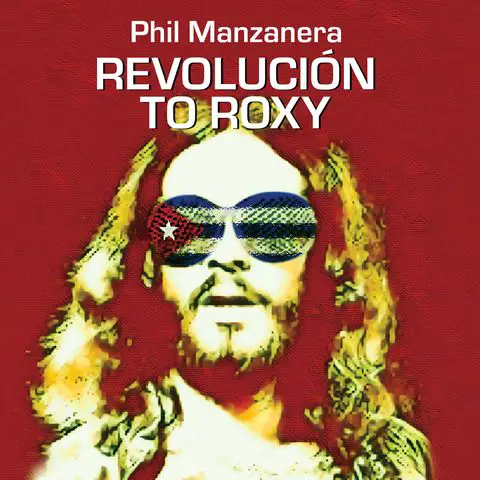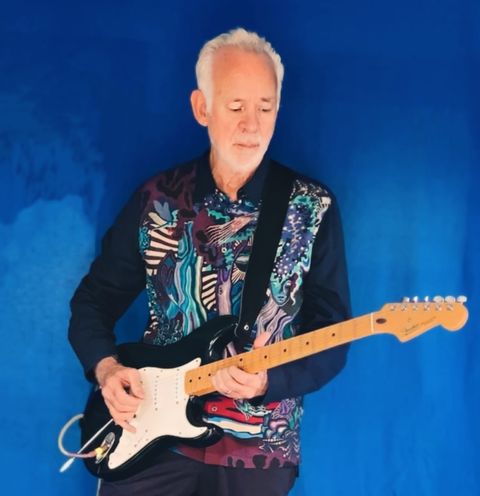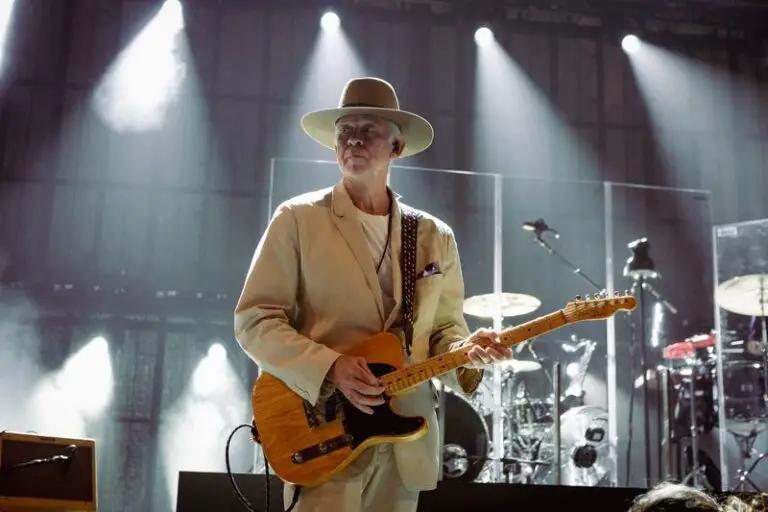

He is one of the most underrated guitarists and producers to come out of the ‘70s British music scene. But now Phil Manzanera, best known as the long-running axe man for glam-cum-art rockers Roxy Music, is telling the story of his globetrotting life, in music and beyond, in a new memoir, Revolución to Roxy (Wordzworth Publishing)

Manzanera’s autobiography goes well beyond the usual, dumbed-down VH-1 “Behind the Music” rise-fall-rise template. As he states in his introduction below, it’s a very personal exploration of his life – one made as much for music fans as it is for his far-flung family.
“I’ve written this memoir for my English and Colombian family, dear friends and music fans, who have followed my musical twists and turns for over half a century. It spans from my 50’s childhood in Cuba, Hawaii and Venezuela, when everything seemed in the brightest technicolor, to grey but very cool ‘60’s London and the start of a music career that continues to enrich my life, some 50 years later. Roxy Music is an important part of the story and I will be forever thankful to the doors it opened for me to a global world of music and musical collaborations. But I hope you’ll find my family history every bit as fascinating as my music adventures, I’m proud to be related to a Colombian pirate, a spy and an Italian opera musician.”

On the musical front, Phil is best known for his 50 years with Roxy Music, from its incredible 1972 debut disc to its final 50th Anniversary tour. In the band’s early days, it was the two Bs – Bryan Ferry and Brian Eno – who sucked up most of the limelight. But it was Manzanera’s searing, melodic and uniquely treated guitar riffage that brought the fire to Roxy’s post-modern mélange, along with the Bonham-like thump of the equally-underrated drummer Paul Thompson.
Roxy Music “Ladytron” on BBC 1972
But outside of Roxy, Manzanera has plied a productive career as a solo artist, producer and collaborator. He has worked as a sideman, producer and songwriter partner with greats like Bob Dylan, Brian Eno, Robert Wyatt, John Cale, Split Enz and David Gilmour, both solo and in the final works of Pink Floyd. He also became one of the most prominent producers of Rock En Espanol.
The story of Phil’s much-traveled youth is one of the more engaging parts of the book. Phillip Targett-Adams was born in England to a British father and Colombian mother whose surname he would take for his life on the stage. His father’s work for a British airline company (and maybe as a spy?) would take young Phil to Venezuela, Hawaii and, most notably, Cuba where he witnessed the Fidel Castro-led revolution. He would become fascinated with the guitar while living in Cuba and make his first forays into playing while at board school in England, with the purchase of a Hofner Galaxie which he still has. There, he would form a musical partnership with bassist Bill McCormick which would fully flower in the collaborations with Eno and with an album by his immediate pre-Roxy prog band, Quiet Sun.
Manzanera’s memories of the early Roxy Music days will provide plenty of juice for glam music fans. Phil would fail his first audition with the band and get his signature “look” – the bug-eye sunglasses – when the band’s stylist pulled them out of a bag of accessories during the first album photo shoot. Wearing them while playing guitar would prove a challenge Phil would have to endure through the band’s early rise.

Roxy Music fans will enjoy his description of the band’s unique working style. The detail-oriented control freak leader, Bryan Ferry, would come up with all the music first and, only after it was recorded, would he write lyrics. After the basic tracks were laid down, Phil would take them home and work out different guitar parts on tape, which would then be assessed and the best recorded. He also discussed the inevitable parting of Eno from the band, perhaps due to the fact that Brian had much more success with the ladies than Ferry? We also hear how he purchased his signature guitar, the “Cardinal Red” 1964 Gibson Firebird VII. And also how he broke his leg falling off the six-inch platform shoes that were required wardrobe in the glam rock days.
As with all too many musician memoirs, Phil’s demonstrates how an artist’s fortunes can suffer from bad management. According to Manzanera, Roxy only received 5% of the monies earned from early albums, a sum that would be divided equally amongst the six members. It would be 12 years before he earned anything meaningful from his recording and touring with Roxy Music.
Roxy Guitar Solo “Dream Home” https://www.youtube.com/watch?v=0KODD2sjfH0
There is great context about his collaborations with Brian Eno on his legendary early solo album, their work in the band 801, the Quiet Sun project and Phil’s acclaimed early solo albums, Diamond Head, Primitive Guitars and K-Scope. It’s a tune from the last album than would pay huge and unexpected dividends decades after its release.
Phil would go on to be the director of Guitar Legends, a 5-day concert extravaganza featuring B.B. King, Brian May, Steve Vai, Joe Walsh, Jack Bruce, Keith Richards, Bob Dylan and many more, produced in tandem with Expo ‘92 in Seville, the birthplace of the guitar. His Latin roots would make him the choice producer for many of the biggest Rock En Espanol acts including Heroes de Silencio and the later solo work of its leader, Enrique Bunbury. Also discussed are the many productions created at Gallery Studio at his home in Sussex, St. Ann’s Court. These included latter-day Roxy Music albums like Avalon, their biggest commercial success.
Manzanera also elaborates on his extensive role as a co-writer, guitarist and producer for the post-Roger Waters era Pink Floyd and the solo work of its guitarist, David Gilmore. Phil would earn composer credit on tracks like Floyd’s “Learning to Fly” and producer credit on albums like their final work, The Endless River. He would serve as producer of various David Gilmour solo albums from 2006 – 2015, including On An Island, Live in Gdansk and Rattle That Lock. During Covid, he would remotely wax three albums with Tim Finn of The Split Enz.

Roxy Music fans will get Phil’s take on the many fits and starts of their career, including three big breakups and reformations through their final world tour in 2022 and Rock and Roll Hall of Fame Induction. He compares Roxy to one of his vintage cars, a Rolls Royce, saying – It’s beautiful to look at, but very hard to drive.”
Manzanera’s biggest financial windfall would come not from rock but rap. That would arrive in 2011 when a beat-maker named 88 Keys would sample a guitar riff from a tune on his 1978 album K-Scope for use in a Jay-Z/Kayne West track, “No Church In the Wild” on their album, Watch the Throne. Manzanera was allocated one-third of resulting royalties and publishing revenue for the song, more than either of the rappers. The album went Gold in the UK and Platinum in the US, and the song was used in the film The Great Gatsby and various tv commercials.
In his book, Manzanera states that he earned more from “this brief sequence of maybe twenty notes” than he had in his 50 years with Roxy Music.
Phil on the Jay-Z/Kayne Sample – https://www.youtube.com/watch?v=A61-wcM9sQo
Bio: Sal Cataldi is a musician, writer and publicist living in the Hudson Valley and NYC. He is President of Cataldi PR and leader of the band Spaghetti Eastern Music and member of the ensembles Guitars A Go Go, Vapor Vespers and spaceheater.
The post Roxy Music’s Phil Manzanera Discusses His Half Century in Music & Intriguing Family History in Revolución to Roxy appeared first on NYS Music.



![NYC Marathon Keyboard Solo Guy Dishes On His Viral Mid-Race Jam Session [Interview/Videos]](https://utterbuzz.com/wp-content/uploads/2024/11/nyc-marathon-keyboard-solo-guy-dishes-on-his-viral-mid-race-jam-session-interview-videos-238x178.jpg)




